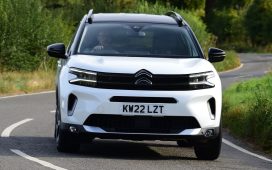Buried in the Infrastructure Investment and Jobs Act is a possible way to address all the costs associated with Americans’ love of driving.
BC-OPINION-WINSTON-INFRASTRUCTURE-ACT-ART-NYTSF — The Little-Known Provision That Could Revolutionize Highway Travel (Brendan Conroy for The New York Times) — ONLY FOR USE WITH ARTICLE SLUGGED —BC-OPINION-WINSTON-INFRASTRUCTURE-ACT-ART-NYTSF — OTHER USE PROHIBITED.
It’s no small irony that so much federal money is being dedicated in various ways to climate-change projects that will do nothing to curtail Americans’ love of driving or to reduce the costs associated with it.
The country’s road system receives much of its funding through a tax on gasoline, and the Infrastructure Investment and Jobs Act and the Inflation Reduction Act have allocated billions of dollars of additional federal spending to improve our highways and to subsidize the purchase of electric vehicles. In theory, both new laws should help address climate change. Newer roads should reduce stop-and-go traffic, which increases emissions, and electric vehicles will eventually slash motor vehicle gasoline emissions.
But in reality, building smoother and wider roads often incentivizes more, not less, driving. And of course, more driving means more pollution, more accidents, more congestion and more pavement damage. At the same time, the gas tax revenues providing highway funding will dwindle because of electric vehicle adoption.
The good news: Buried in the 2,700 pages of the Infrastructure Investment and Jobs Act is the money to test a simple, relatively inexpensive and far better way to fix many of the woes of our congested, crumbling and climate-unfriendly highway system.
Known as a vehicle miles traveled (V.M.T.) fee, it would charge drivers for each mile of their use of the road. In doing so, it can incentivize us to drive less often, to avoid peak travel periods and to drive less-damaging and less-polluting vehicles.
To understand the importance of the solution, let’s return to the problem. In 1956, America began constructing its more than 40,000-mile federal interstate highway system, ensuring that the nation’s roads would be the lifeblood of travel. However, as more motorists and truckers used the roads, the annual costs of accidents, congestion, vehicle pollutants and pavement damage have exceeded a trillion dollars.
By focusing on miles driven, the V.M.T. fee can be fine-tuned to address all the social costs associated with driving. It can be increased during peak travel periods and in more populous areas, reducing congestion and improving safety. It can be varied depending on how green (or not) the vehicle is and can charge drivers according to the pollution their vehicles emit.
And it can be designed to reduce the considerable damage caused by heavy trucks. The gas tax encourages truckers to improve fuel efficiency by relying on vehicles with fewer axles — which increases road damage. A V.M.T. fee can be varied depending on how much weight is being borne by each axle, which reflects the road damage trucks inflict on the pavement.
Advances in technology make a V.M.T. fee for cars and trucks feasible; a mobile device can be installed on all vehicles that can track time, location and mileage, and the information can be sent to administrators who send confidential charges to road users. As for privacy concerns, many of us are already using a similar technology to pay highway tolls.
Establishing a V.M.T. fee would achieve the government’s goals for much less than those large spending programs. The congestion charge would spread traffic throughout the day, reducing public pressure to build expensive lanes or roads to expand peak-period capacity. The axle-weight charge would reduce pavement damage, decreasing maintenance expenditures. And the emissions charge would encourage travelers to use electric vehicles, accelerating the transition to a clean energy economy without large subsidies.
A V.M.T. fee can also help prepare the road system for the future. Travelers and shippers will almost certainly eventually use autonomous electric vehicles that operate efficiently and safely without a driver to reach their destinations. Those vehicles could communicate electronically with other vehicles to avoid collisions and even with the highway infrastructure to maintain smooth traffic flow. To a visionary policymaker, V.M.T. fees would generate funding to upgrade the highway infrastructure, thus reducing congestion and pavement damage that impede autonomous vehicle operations, and accelerate demand for autonomous electric vehicles.
The timeliest argument for a V.M.T. fee is that the gas tax will have to be replaced eventually because the adoption of electric vehicles is growing and revenue generated by the gas tax is shrinking. Fairness calls for electric vehicles to be charged for the emissions they generate from consuming electricity as well as for their congestion and accident costs.
Despite all the potential benefits of a V.M.T. fee, a huge hurdle remains to its being used more widely: the nature of American politics. Policymakers have historically favored inefficient, large spending programs because it is more politically attractive to spend money to build roads and to attend ribbon-cutting ceremonies than to charge road users for the social cost of their transportation.
Accordingly, I was not surprised to recently learn that the Department of Transportation reportedly has not made much, if any, progress on a V.M.T. pilot program. I understand that executive agencies routinely miss congressional deadlines because they feel overwhelmed and prioritize their responsibilities based on political considerations. But where does that leave us with a V.M.T. fee?
The most likely outcome is that policymakers will let the clock run out by allowing the 2024 elections to take precedence over everything else. Support for testing and establishing a V.M.T. fee might be resurrected after the elections, or it might be done in future decades to help upgrade the infrastructure to facilitate autonomous vehicles operation. It would be socially desirable to put a V.M.T. fee in place as soon as possible, but like many important policies, some legislative actions do not even get out of the starting gate even though the future pleads for them to be carried out now.
Clifford Winston is a senior fellow at the Brookings Institution and an author of the forthcoming book “Revitalizing a Nation: Competition and Innovation in the U.S. Transportation System.” This article originally appeared in The New York Times.










